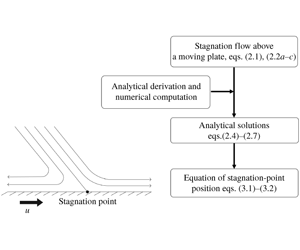No CrossRef data available.
Article contents
On the stagnation point position of the flow impinging obliquely on a moving flat plate
Published online by Cambridge University Press: 28 February 2020
Abstract

To study the variation of the stagnation point position of the flow impinging obliquely on a moving flat plate, we follow the mathematical approach of Dorrepall (J. Fluid Mech., vol. 163, 1986, p. 141) and obtain the analytical solution of the flow. Based on the solution, we derive an equation governing the variation of stagnation point position with both the plate velocity as well as the impinging angle. Results show that, when the plate is stationary, the stagnation point will stay in upstream if the flow is non-orthogonal, as concluded by previous studies. As soon as the plate starts to move, the stagnation point will move from upstream to downstream when the plate velocity increases beyond a small critical value, no matter whether the flow is orthogonal or non-orthogonal.
JFM classification
- Type
- JFM Papers
- Information
- Copyright
- © The Author(s), 2020. Published by Cambridge University Press




